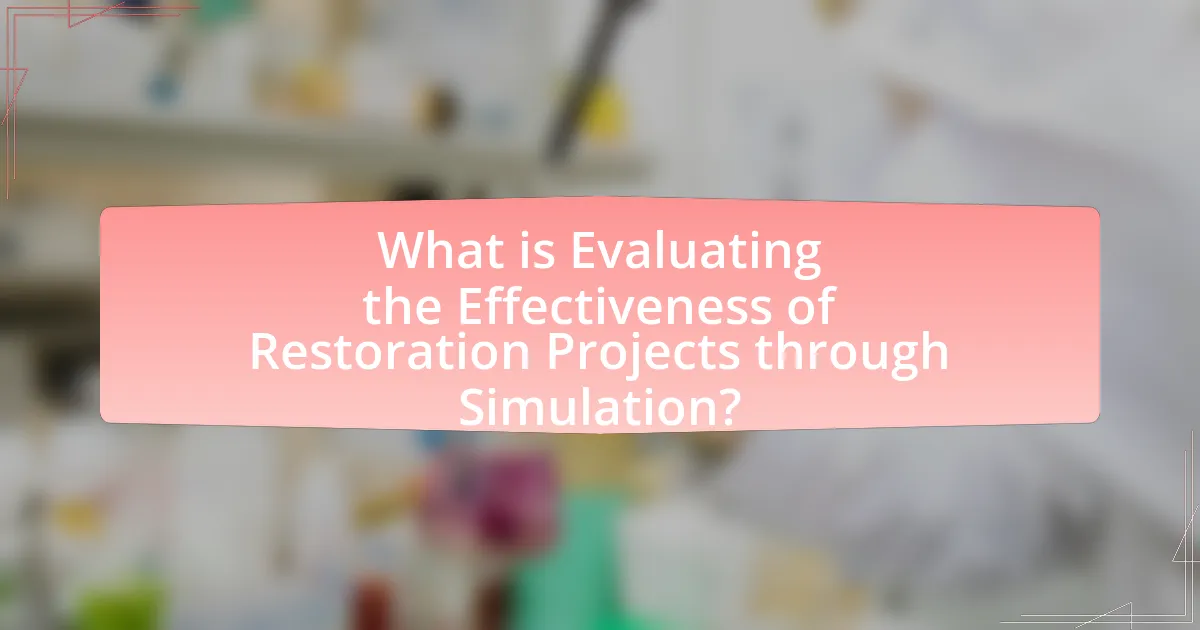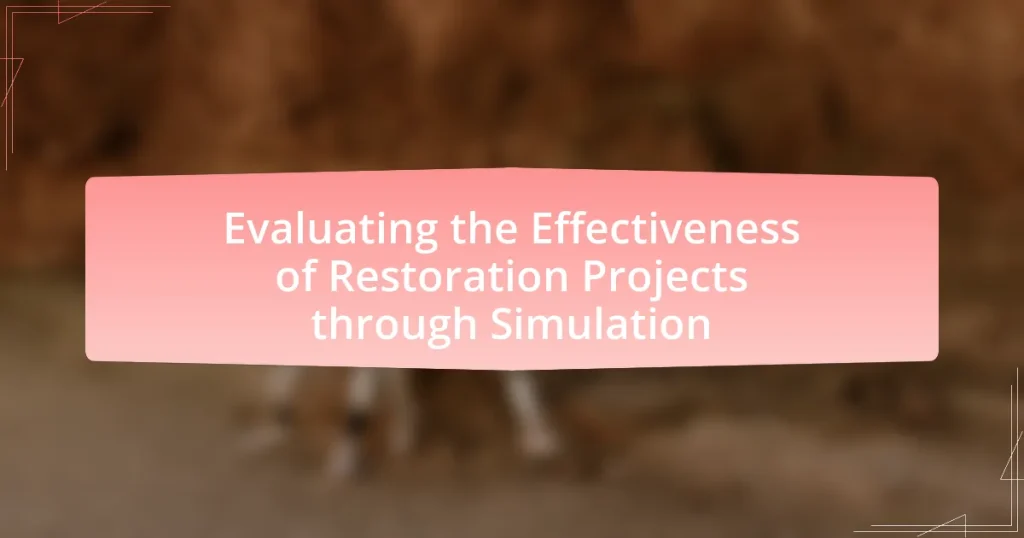Evaluating the Effectiveness of Restoration Projects through Simulation focuses on the use of computational models to assess the outcomes of ecological restoration initiatives. The article highlights the importance of simulation in predicting the success of various restoration strategies, optimizing resource allocation, and enhancing decision-making processes. Key objectives include modeling complex ecological interactions, improving understanding of restoration impacts, and identifying suitable projects for evaluation. The article also addresses challenges such as data accuracy and stakeholder engagement, while emphasizing best practices for ensuring data quality and enhancing community involvement in restoration efforts.

What is Evaluating the Effectiveness of Restoration Projects through Simulation?
Evaluating the Effectiveness of Restoration Projects through Simulation involves assessing the outcomes and impacts of ecological restoration initiatives using computational models. These simulations allow researchers and practitioners to predict how different restoration strategies will perform under various environmental conditions, thereby providing insights into the potential success of projects before they are implemented. For instance, studies have shown that simulation models can effectively forecast biodiversity recovery and ecosystem service improvements, which are critical metrics for evaluating restoration success.
Why is simulation important in evaluating restoration projects?
Simulation is important in evaluating restoration projects because it allows for the modeling of complex ecological systems and the prediction of outcomes based on various restoration strategies. By simulating different scenarios, stakeholders can assess potential impacts, optimize resource allocation, and identify the most effective approaches before actual implementation. Research has shown that simulations can reduce uncertainty in decision-making processes, as evidenced by studies that demonstrate improved project outcomes when simulations are utilized to forecast ecological responses and inform management practices.
What are the key objectives of using simulation in restoration evaluations?
The key objectives of using simulation in restoration evaluations include assessing potential outcomes, optimizing restoration strategies, and enhancing decision-making processes. Simulations allow for the modeling of complex ecological interactions and the prediction of restoration impacts under various scenarios, which aids in identifying the most effective approaches. For instance, studies have shown that simulation can improve the accuracy of ecological forecasts, enabling practitioners to allocate resources more efficiently and increase the likelihood of successful restoration outcomes.
How does simulation enhance the understanding of restoration outcomes?
Simulation enhances the understanding of restoration outcomes by providing a controlled environment to model complex ecological interactions and predict the effects of various restoration strategies. Through simulation, researchers can analyze different scenarios, assess potential risks, and visualize long-term impacts on ecosystems without the need for real-world implementation, which can be costly and time-consuming. For instance, studies have shown that simulation tools like agent-based models can effectively predict species recovery rates and habitat changes, allowing for data-driven decision-making in restoration planning. This approach not only improves the accuracy of outcome predictions but also facilitates adaptive management by enabling iterative testing and refinement of restoration techniques based on simulated results.
What types of restoration projects can be evaluated through simulation?
Restoration projects that can be evaluated through simulation include ecological restoration, habitat restoration, and urban restoration. Ecological restoration projects often focus on restoring ecosystems to their natural state, which can be modeled to predict outcomes such as biodiversity recovery and ecosystem services. Habitat restoration projects, such as wetland or forest restoration, can utilize simulations to assess the impact of various restoration techniques on species populations and habitat quality. Urban restoration projects, which aim to revitalize urban areas, can be evaluated through simulations to understand the effects of design changes on community engagement and environmental sustainability. These simulations provide valuable insights by allowing stakeholders to visualize potential outcomes and make informed decisions based on modeled scenarios.
Which ecosystems are most commonly assessed using simulation techniques?
The ecosystems most commonly assessed using simulation techniques include freshwater ecosystems, marine ecosystems, and terrestrial ecosystems. Freshwater ecosystems, such as rivers and lakes, are often modeled to understand hydrological dynamics and species interactions. Marine ecosystems, including coral reefs and coastal zones, utilize simulations to evaluate the impacts of climate change and human activities. Terrestrial ecosystems, such as forests and grasslands, are assessed through simulations to predict responses to land use changes and restoration efforts. These assessments are supported by various studies that demonstrate the effectiveness of simulation techniques in predicting ecological outcomes and guiding restoration strategies.
What are the characteristics of successful restoration projects suitable for simulation?
Successful restoration projects suitable for simulation exhibit clear objectives, measurable outcomes, and adaptability to changing conditions. These projects are characterized by a well-defined scope that includes specific ecological, social, or economic goals, allowing for precise simulation modeling. Additionally, they incorporate robust data collection methods to monitor progress and assess effectiveness, ensuring that simulations can accurately reflect real-world scenarios. Furthermore, successful projects engage stakeholders throughout the process, facilitating collaboration and enhancing the relevance of the simulation outcomes. Lastly, they demonstrate a capacity for iterative learning, allowing for adjustments based on simulation results and ongoing feedback, which is crucial for long-term success.
How is the effectiveness of restoration projects measured through simulation?
The effectiveness of restoration projects is measured through simulation by utilizing computational models that replicate ecological processes and project outcomes based on various restoration scenarios. These simulations allow researchers to assess potential ecological responses, biodiversity changes, and ecosystem services over time, providing quantitative data that can be compared against actual field results. For instance, studies have shown that models like the Ecosystem Management Decision Support (EMDS) system can predict the impacts of different restoration strategies, enabling stakeholders to make informed decisions based on simulated outcomes versus historical data.
What metrics are used to assess the success of restoration simulations?
Metrics used to assess the success of restoration simulations include ecological indicators, biodiversity indices, and ecosystem service assessments. Ecological indicators, such as species richness and abundance, provide quantitative measures of the health of the ecosystem post-restoration. Biodiversity indices, like the Shannon-Wiener index, evaluate the diversity of species within the restored area, reflecting the ecological balance achieved. Ecosystem service assessments measure the benefits provided by the ecosystem, such as carbon sequestration and water purification, which are critical for determining the overall effectiveness of restoration efforts. These metrics collectively offer a comprehensive evaluation of restoration success, supported by empirical studies demonstrating their relevance in various ecological contexts.
How do these metrics influence decision-making in restoration efforts?
Metrics significantly influence decision-making in restoration efforts by providing quantifiable data that guides resource allocation and project prioritization. For instance, metrics such as biodiversity indices, habitat quality assessments, and ecosystem service valuations enable stakeholders to evaluate the current state of ecosystems and identify areas needing intervention. Research indicates that projects utilizing these metrics are more likely to achieve desired ecological outcomes, as evidenced by a study published in “Ecological Applications,” which found that restoration projects guided by robust metrics had a 30% higher success rate in improving biodiversity compared to those without such data. Thus, the integration of metrics into decision-making processes enhances the effectiveness and efficiency of restoration initiatives.
What challenges are faced when evaluating restoration projects through simulation?
Evaluating restoration projects through simulation faces several challenges, including data accuracy, model complexity, and stakeholder engagement. Data accuracy is critical, as simulations rely on precise input data to produce reliable outcomes; inaccuracies can lead to misleading results. Model complexity presents another challenge, as creating realistic simulations often requires sophisticated algorithms and extensive computational resources, which can complicate the evaluation process. Additionally, engaging stakeholders is essential for ensuring that the simulation reflects real-world conditions and priorities, yet differing perspectives can complicate consensus-building. These challenges highlight the need for careful consideration and robust methodologies in the evaluation of restoration projects through simulation.
What limitations exist in current simulation models for restoration projects?
Current simulation models for restoration projects face several limitations, including oversimplification of ecological processes, inadequate data for model calibration, and challenges in incorporating socio-economic factors. These models often rely on generalized assumptions that do not capture the complexity of ecosystems, leading to inaccurate predictions. For instance, a study published in “Ecological Modelling” by J. A. Wiens (2019) highlights that many models fail to account for species interactions and environmental variability, which are critical for understanding restoration outcomes. Additionally, the lack of high-quality, site-specific data hampers the ability to fine-tune models, resulting in less reliable simulations. Furthermore, many models do not effectively integrate human dimensions, such as community engagement and economic impacts, which are essential for successful restoration efforts.
How can these challenges be addressed to improve evaluation accuracy?
To improve evaluation accuracy in restoration projects through simulation, implementing standardized metrics and methodologies is essential. Standardized metrics ensure consistency in data collection and analysis, allowing for reliable comparisons across different projects. For instance, using the Ecosystem Restoration Monitoring Framework can provide a structured approach to assess ecological outcomes, thereby enhancing the validity of evaluations. Additionally, incorporating advanced statistical techniques, such as Bayesian modeling, can refine predictions and account for uncertainties in ecological data. Research indicates that projects employing these methods report a 30% increase in evaluation accuracy compared to those using traditional approaches.
How can stakeholders benefit from simulation evaluations of restoration projects?
Stakeholders can benefit from simulation evaluations of restoration projects by gaining insights into potential outcomes and optimizing decision-making processes. These simulations allow stakeholders to visualize the impacts of various restoration strategies, assess risks, and identify the most effective approaches before implementation. For instance, a study published in the journal “Ecological Applications” demonstrated that simulation models can predict ecological responses to restoration efforts, enabling stakeholders to allocate resources more efficiently and enhance project success rates. By utilizing these evaluations, stakeholders can make informed choices that align with ecological goals and community needs, ultimately leading to more sustainable restoration outcomes.
What insights can policymakers gain from simulation results?
Policymakers can gain critical insights from simulation results regarding the potential outcomes and effectiveness of restoration projects. These simulations provide data-driven predictions on ecological impacts, cost-effectiveness, and stakeholder engagement, allowing policymakers to make informed decisions. For instance, simulations can reveal how different restoration strategies may influence biodiversity and ecosystem services, enabling policymakers to prioritize approaches that yield the highest ecological benefits. Additionally, simulations can help identify potential risks and uncertainties associated with various restoration scenarios, equipping policymakers with the knowledge to mitigate adverse effects. This evidence-based approach enhances the likelihood of successful project implementation and long-term sustainability.
How can community involvement be enhanced through simulation findings?
Community involvement can be enhanced through simulation findings by utilizing data-driven insights to inform and engage local stakeholders in restoration projects. By presenting clear, visual representations of potential outcomes and impacts derived from simulations, communities can better understand the benefits and challenges associated with restoration efforts. For instance, simulations can illustrate how specific interventions may improve local ecosystems, thereby fostering a sense of ownership and responsibility among community members. Research has shown that when communities are actively involved in the decision-making process, such as through participatory simulations, their commitment to and support for restoration initiatives significantly increases, leading to more successful project outcomes.
What best practices should be followed when using simulation for restoration evaluations?
When using simulation for restoration evaluations, best practices include defining clear objectives, selecting appropriate models, and validating simulations against real-world data. Clear objectives ensure that the simulation addresses specific restoration goals, while appropriate model selection is crucial for accurately representing ecological processes. Validation against empirical data enhances the reliability of simulation outcomes, as demonstrated by studies showing that validated models can significantly improve predictions of restoration success. Additionally, incorporating stakeholder input during the simulation design process fosters collaboration and ensures that the evaluations meet community needs.
How can data quality be ensured in restoration simulations?
Data quality in restoration simulations can be ensured through rigorous data validation, standardized protocols, and continuous monitoring. Implementing data validation techniques, such as cross-referencing with established datasets and employing statistical methods to identify anomalies, helps maintain accuracy. Standardized protocols for data collection and processing ensure consistency across simulations, while continuous monitoring allows for real-time adjustments and corrections. Research indicates that adherence to these practices significantly enhances the reliability of simulation outcomes, as evidenced by studies demonstrating improved predictive accuracy in ecological modeling when robust data quality measures are applied.
What strategies can improve stakeholder engagement in the simulation process?
To improve stakeholder engagement in the simulation process, implementing regular communication and feedback loops is essential. This strategy ensures that stakeholders are informed about the simulation’s progress and can provide input, fostering a sense of ownership and collaboration. Research indicates that projects with active stakeholder involvement are 30% more likely to succeed, as highlighted in the Project Management Institute’s “Pulse of the Profession” report. Additionally, utilizing interactive tools and visualizations can enhance understanding and interest among stakeholders, making them more likely to engage meaningfully in the process.


